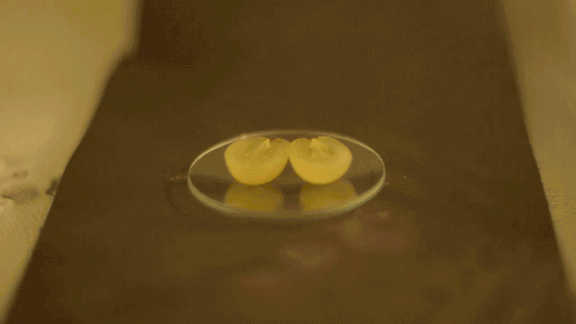Why Do Grapes Send Sparks Flying in the Microwave?
The effect can be replicated with just about any grape-sized, water-based sphere, from large blackberries to gooseberries, quail eggs and hydrogel beads
/https://tf-cmsv2-smithsonianmag-media.s3.amazonaws.com/filer/0a/82/0a821a67-0bf3-404a-8f74-b18d7dfa335d/grapeplamsa-1-3max-800x600.jpg)
In 1995, Aaron Slepkov chanced upon a website describing the unusual phenomenon of plasma-producing microwaved grapes. Immediately intrigued, the future Trent University physicist kept the idea in the back of his mind as he moved forward in his career. Now, nearly 25 years later, Popular Mechanics’ Jacqueline Detwiler reports that Slepkov has co-authored the first academic study to explore the fiery trick in-depth.
Most iterations of the YouTube stunt-turned-experiment begin by popping grapes slashed nearly in half—but still connected by a strip of skin—into the microwave. After a few seconds, Natalie Parletta explains for Cosmos, the grapes ignite, sending sparks of plasma into the air.
Prior to the publication of the new Proceedings of the National Academy of Sciences paper, no one had actually taken the time to delve into the science behind this reaction. As Wired’s Sophia Chen writes, the dominant hypothesis posited that the two grape halves served as makeshift antenna, directing an electrical current across the skin connecting the divided fruit.
This spark, in turn, was believed to generate plasma, a gas-like state of matter made up of charged atoms, notes NOVA Next’s Katherine J. Wu. Plasma, naturally found in lightning and the sun’s corona, can be artificially produced with the help of intense bursts of energy that displace atoms’ negatively charged electrons.
Actually, neither halved grapes nor a so-called “skin bridge” are required to set off a burst of plasma, study co-author Pablo Bianucci of Montreal’s Concordia University tells Popular Mechanics. Instead, Bianucci, Slepkov and Hamza Khattak, a Trent University undergraduate student, found that the effect can be replicated with just about any grape-sized, water-based sphere, including large blackberries, gooseberries, quail eggs and even hydrogel water beads.

The key, NOVA's Wu reports, is ensuring there are at least two objects placed in direct contact with each other. When the microwaves that power your appliance hit the connected grapes or a similarly sized spherical pair, they concentrate energy into a smaller than average space—namely, the millimeters-wide point where the objects meet—and produce the electric sparks in question.
Discover magazine's Nathaniel Scharping outlines another way of looking at the fruity explosions: As he notes, grapes’ diameters roughly match up with microwaves’ wavelengths, creating a perfect storm of sorts that “traps” the microwaves inside of the fruits. When trapped energy forms a hotspot at the intersection between the two grapes, heat quickly builds up enough to generate plasma.
Despite the seemingly benign nature of heating up grapes in the microwave, Atlas Obscura’s Anne Ewbank writes that the team spent several years conducting research with the help of heavily modified microwaves, thermal-imaging techniques and computer simulations. In total, the scientists burned through a staggering 12 microwaves. (As Ars Technica’s Jennifer Oullette explains, operating nearly empty microwaves generates ample amounts of “damaging unabsorbed radiation.”)
Although the implications of the study may appear inconsequential at first glance, Ewbank points out that the research could help further the burgeoning field of nanophotonics, or the study of light on an extremely small scale. This, in turn, may have implications for surgery, space travel and national security, as Popular Mechanics’ Detwiler adds.
In the meantime, Slepkov, Bianucci and Khattak’s findings may elucidate the wider issue of why certain foods—according to NPR’s Erin Ross, kale, green beans and carrots are amongst the vegetables known to spark in the microwave—have an electric reaction to the speedy heating process.
Still, NOVA’s Wu cautions, no scientists are actively encouraging readers try to replicate these kinds of experiments at home.
“You have to be careful about not melting a hole in the top of your microwave,” Khattak tells Wu. “I mean, you could give this a try, but I wouldn’t recommend it.”
/https://tf-cmsv2-smithsonianmag-media.s3.amazonaws.com/accounts/headshot/mellon.png)
/https://tf-cmsv2-smithsonianmag-media.s3.amazonaws.com/accounts/headshot/mellon.png)